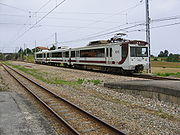
FEVE
Encyclopedia


Spain
Spain , officially the Kingdom of Spain languages]] under the European Charter for Regional or Minority Languages. In each of these, Spain's official name is as follows:;;;;;;), is a country and member state of the European Union located in southwestern Europe on the Iberian Peninsula...
railway company, which operates most of Spain's 1250 km (777 mi) of metre gauge railway
Metre gauge
Metre gauge refers to narrow gauge railways and tramways with a track gauge of . In some African, American and Asian countries it is the main gauge. In Europe it has been used for local railways in France, Germany, and Belgium, most of which were closed down in mid 20th century. Only in Switzerland...
.
History
FEVE was created in 1965, as a successor to the government-run organization EFE (Explotación de Ferrocarriles por el Estado), which had been taking over failed private railways since 1926. Following the creation in 1941 of RENFERENFE
Renfe Operadora is the state-owned company which operates freight and passenger trains on the 1668-mm "Iberian gauge" and 1435-mm "European gauge" networks of the Spanish national railway infrastructure company ADIF .- History :The name RENFE is derived from that of the former Spanish National...
, to which the ownership of all Spanish broad-gauge railways was transferred, EFE had in practice become the operator of a collection of exclusively narrow-gauge lines. The present status of FEVE, as a government-owned commercial company, dates from 1972.
The new company continued to absorb independent narrow-gauge lines which the existing concession holders had been unable to make profitable. However, from 1978 onwards, with the introduction of regional devolution
Devolution
Devolution is the statutory granting of powers from the central government of a sovereign state to government at a subnational level, such as a regional, local, or state level. Devolution can be mainly financial, e.g. giving areas a budget which was formerly administered by central government...
under the new Spanish constitution
Constitution
A constitution is a set of fundamental principles or established precedents according to which a state or other organization is governed. These rules together make up, i.e. constitute, what the entity is...
, FEVE also began transferring responsibility for a number of its operations to the new regional governments. This happened in Catalonia
Catalonia
Catalonia is an autonomous community in northeastern Spain, with the official status of a "nationality" of Spain. Catalonia comprises four provinces: Barcelona, Girona, Lleida, and Tarragona. Its capital and largest city is Barcelona. Catalonia covers an area of 32,114 km² and has an...
in 1978, in the Valencian Community
Valencian Community
The Valencian Community is an autonomous community of Spain located in central and south-eastern Iberian Peninsula. Its capital and largest city is Valencia...
in 1986, with a part of the Basque
Basque Country (autonomous community)
The Basque Country is an autonomous community of northern Spain. It includes the Basque provinces of Álava, Biscay and Gipuzkoa, also called Historical Territories....
network in 1979, and with Majorcan Railways in 1994. That did not occur, however, in the Murcia (autonomous community) region, where the narrow-gauge railway network still remains under FEVE control. The above mentioned EFE (Explotación de Ferrocarriles por el Estado) also operated the local suburbano railway in the town of Madrid
Madrid
Madrid is the capital and largest city of Spain. The population of the city is roughly 3.3 million and the entire population of the Madrid metropolitan area is calculated to be 6.271 million. It is the third largest city in the European Union, after London and Berlin, and its metropolitan...
. This railway became part of the city's subway Metro de Madrid as its Line 10
Line 10 (Madrid Metro)
Line 10 of the Madrid Metro is in fact the product of two lines, the former line 8 from Fuencarral to Nuevos Ministerios and the former Suburbano from Alonso Martínez to Aluche, this section being named line 10 in the 1980s. In the 1990s, Madrid planned for these two lines to become one, but...
.
Operations today
The great majority of the narrow-gauge lines still operated by FEVE are located along or near Spain's Atlantic OceanAtlantic Ocean
The Atlantic Ocean is the second-largest of the world's oceanic divisions. With a total area of about , it covers approximately 20% of the Earth's surface and about 26% of its water surface area...
and Bay of Biscay
Bay of Biscay
The Bay of Biscay is a gulf of the northeast Atlantic Ocean located south of the Celtic Sea. It lies along the western coast of France from Brest south to the Spanish border, and the northern coast of Spain west to Cape Ortegal, and is named in English after the province of Biscay, in the Spanish...
coastline, which stretches from Galicia in the northwest, through Asturias
Asturias
The Principality of Asturias is an autonomous community of the Kingdom of Spain, coextensive with the former Kingdom of Asturias in the Middle Ages...
and Cantabria
Cantabria
Cantabria is a Spanish historical region and autonomous community with Santander as its capital city. It is bordered on the east by the Basque Autonomous Community , on the south by Castile and León , on the west by the Principality of Asturias, and on the north by the Cantabrian Sea.Cantabria...
to the Basque Country (with a branch extending into Castile and León). Together they form a large and strategically important system, which is why – unlike the other, more isolated regional railways – they have been retained under the integrated management of FEVE.
FEVE operates 1,194 km of track, of which 316 km are electrified.


Transcantábrico line
An exclusive tourist service operated by FEVE is a 650 km (403.9 mi) long line, the Transcantábrico, which runs along the entire length of Spain's north coast, and has connected the cities of San SebastiánSan Sebastián
Donostia-San Sebastián is a city and municipality located in the north of Spain, in the coast of the Bay of Biscay and 20 km away from the French border. The city is the capital of Gipuzkoa, in the autonomous community of the Basque Country. The municipality’s population is 186,122 , and its...
, Bilbao
Bilbao
Bilbao ) is a Spanish municipality, capital of the province of Biscay, in the autonomous community of the Basque Country. With a population of 353,187 , it is the largest city of its autonomous community and the tenth largest in Spain...
, Santander
Santander, Cantabria
The port city of Santander is the capital of the autonomous community and historical region of Cantabria situated on the north coast of Spain. Located east of Gijón and west of Bilbao, the city has a population of 183,446 .-History:...
, Oviedo
Oviedo
Oviedo is the capital city of the Principality of Asturias in northern Spain. It is also the name of the municipality that contains the city....
and Ferrol to Leon
León, Spain
León is the capital of the province of León in the autonomous community of Castile and León, situated in the northwest of Spain. Its city population of 136,985 makes it the largest municipality in the province, accounting for more than one quarter of the province's population...
since 1982. Operated as a holiday service, the carriages of the train are furnished with bedrooms, lounges and restaurants and voyages typically last eight days and seven nights.
FEVE also operate "normal" regional (express and stopping) services (in sections) from Ferrol to Hendaya (some sections operated now by regional operators). One of the longest regular (non-tourist) FEVE service operates between Leon and Bilbao (a journey of some 7 hours).
Commuter services
FEVE also operates a range of cercanías or commuter services. The main commuter area is Cercanías Asturias, where the dense five line FEVE network is totally integrated with the RENFE lines and works effectively as a regional metro system.The Bilbao area has a line running from Bilbao
Bilbao
Bilbao ) is a Spanish municipality, capital of the province of Biscay, in the autonomous community of the Basque Country. With a population of 353,187 , it is the largest city of its autonomous community and the tenth largest in Spain...
's Concordia station to the large town of Balmaseda
Balmaseda
Balmaseda is a town in the Encartaciones region of Biscay in the Spanish Basque Country....
, calling at local villages and settlements on its way through Biscay
Biscay
Biscay is a province of Spain and a historical territory of the Basque Country, heir of the ancient Lord of Biscay. Its capital city is Bilbao...
, as well as the main towns of Basurto, Sodupe, Aranguren
Aranguren
Aranguren is a town and municipality located in the province and autonomous community of Navarre, northern Spain.-External links:**...
, and Zalla
Zalla
Zalla is a town and municipality located in the province of Biscay, in the Autonomous Community of the Basque Country, northern Spain.-External links:*...
.
Goods operations


Iron
Iron is a chemical element with the symbol Fe and atomic number 26. It is a metal in the first transition series. It is the most common element forming the planet Earth as a whole, forming much of Earth's outer and inner core. It is the fourth most common element in the Earth's crust...
, steel
Steel
Steel is an alloy that consists mostly of iron and has a carbon content between 0.2% and 2.1% by weight, depending on the grade. Carbon is the most common alloying material for iron, but various other alloying elements are used, such as manganese, chromium, vanadium, and tungsten...
and coal
Coal
Coal is a combustible black or brownish-black sedimentary rock usually occurring in rock strata in layers or veins called coal beds or coal seams. The harder forms, such as anthracite coal, can be regarded as metamorphic rock because of later exposure to elevated temperature and pressure...
, fuelling much of the country's industry.
Companies operating former FEVE services
- EuskoTrenEuskoTrenEuskoTren is a commuter rail service which operates in the Basque Country provinces of Biscay and Gipuzkoa. It is one of the three commercial brands of the public society owned by the Basque Government, Eusko Trenbideak - Ferrocarriles Vascos...
and Metro BilbaoMetro BilbaoMetro Bilbao is a rapid transit system serving the city of Bilbao and the region of Greater Bilbao. Its lines have a "Y" shape, with two lines that transit both banks of the Nervión river and then combine to form one line that ends in the south of Bilbao...
- in the Basque CountryBasque Country (autonomous community)The Basque Country is an autonomous community of northern Spain. It includes the Basque provinces of Álava, Biscay and Gipuzkoa, also called Historical Territories.... - FGCFerrocarrils de la Generalitat de CatalunyaFerrocarrils de la Generalitat de Catalunya , or FGC, is a railway company which operates several unconnected lines in Catalonia, Spain....
- around BarcelonaBarcelonaBarcelona is the second largest city in Spain after Madrid, and the capital of Catalonia, with a population of 1,621,537 within its administrative limits on a land area of... - FGVFerrocarrils de la Generalitat ValencianaFerrocarrils de la Generalitat Valenciana or FGV is a public Valencian railway company which operates several metre gauge lines, in the Autonomous Community of Valencia, in Spain....
- in the Valencian CommunityValencian CommunityThe Valencian Community is an autonomous community of Spain located in central and south-eastern Iberian Peninsula. Its capital and largest city is Valencia... - SFMServeis Ferroviaris de MallorcaServeis Ferroviaris de Mallorca or SFM is a company which operates the metre gauge railway network on the Spanish island of Majorca.The line Palma - Inca was since 1977 the sole remnant of a network that once connected Palma with most of the island...
- on the island of Majorca - Metro de Madrid - on MadridMadridMadrid is the capital and largest city of Spain. The population of the city is roughly 3.3 million and the entire population of the Madrid metropolitan area is calculated to be 6.271 million. It is the third largest city in the European Union, after London and Berlin, and its metropolitan...
town.
External links
- FEVE website (Spanish)
- Transcantábrico website (English)

